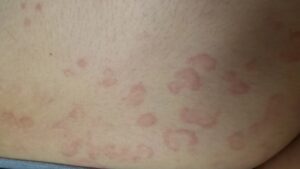July 08, 2025 | Black & Kletz Allergy

Erythema multiforme affects less than 1% of the population. It is most common in young adults (aged 20 – 40 years) with a modest predominance in males. Some people are genetically predisposed to develop erythema multiforme.
Causes:
- Infections – Herpes simplex virus (most common), mycoplasma, cytomegalovirus, Epstein-Barr virus, influenza virus, coronavirus, etc.
- Medications – Antibiotics (e.g., sulfonamides, tetracyclines, erythromycin), aspirin, nonsteroidal anti-inflammatory drugs (NSAIDs) (e.g., ibuprofen, naproxen), anti-seizure medications, and vaccines.
- Systemic disorders – Inflammatory bowel disease, hepatitis, lymphoma, leukemia, and solid organ tumors.
Diagnosis:
- After exposure to the trigger, there is usually a prodromal period when the individual may experience mild fever, cold like symptoms, sore throat, headache, fatigue, and/or achiness.
- A few days later, the typical skin lesions will erupt. These lesions may be in the form of red papules (i.e., small raised bumps), vesicles (i.e., blisters filled with clear fluid), ulcers (i.e., skin sores), etc.
- Characteristic lesions are ‘bulls-eye’ target lesions with a central dusky area, surrounded by a pale edematous area and a peripheral reddish ring, demarcating it from the surrounding normal skin.
- Atypical lesions are raised with poorly defined borders and/or fewer zones of color variation.
- Several lesions in different developmental stages may be seen at the same time.
- The skin lesions are usually symmetrical, begin at the periphery and spread centrally. The skin lesions usually have a predilection to extensor surfaces (i.e., outer side of the limbs)
- Skin lesions may be very itchy, painful, and/or swollen.
- Confirmation of the diagnosis may require a skin biopsy.
- Tests for infections, especially herpes simplex virus, are needed.
Types:
- Erythema multiforme minor – Mild form of the illness that only affects the skin and causes a rash.
- Erythema multiforme major – Most severe form of the condition which may be life-threatening because it causes large areas of the skin to blister and peel. This type affects the mucus membranes in the mouth, eyes, and genitals. Individuals usually have systemic symptoms such as fevers and/or joint pain.
Erythema multiforme is not contagious. The lesions, blisters, or rash on the skin cannot spread from person to person. The viruses and other agents that caused the infection, however, can spread from one person to another.
Treatment:
- Most cases of erythema multiforme are mild and self-limiting and usually resolve spontaneously after a few days or weeks.
- Antihistamines and topical corticosteroid medications are helpful in relieving the itching and discomfort associated with more severe skin lesions.
- Antiseptic and local anesthetic mouthwashes may help relieve the pain and irritation associated with mucus membrane lesions inside the mouth.
- Antihistamine or anti-inflammatory eye drops can treat redness, burning, and/or excessive tearing of the eyes.
- Proper care of skin lesions such as avoidance of scratching will help prevent the spread of infections.
- Most severe cases may need a course of systemic corticosteroids such as oral prednisone.
- Recurrent cases are usually treated with 6 months or more of continuous oral antiviral medications such as acyclovir.
Prevention:
- General hand and respiratory hygiene is important in order to reduce the risk of contracting viral and bacterial infections.
- Avoiding medications that had previously caused adverse reactions in the past.












